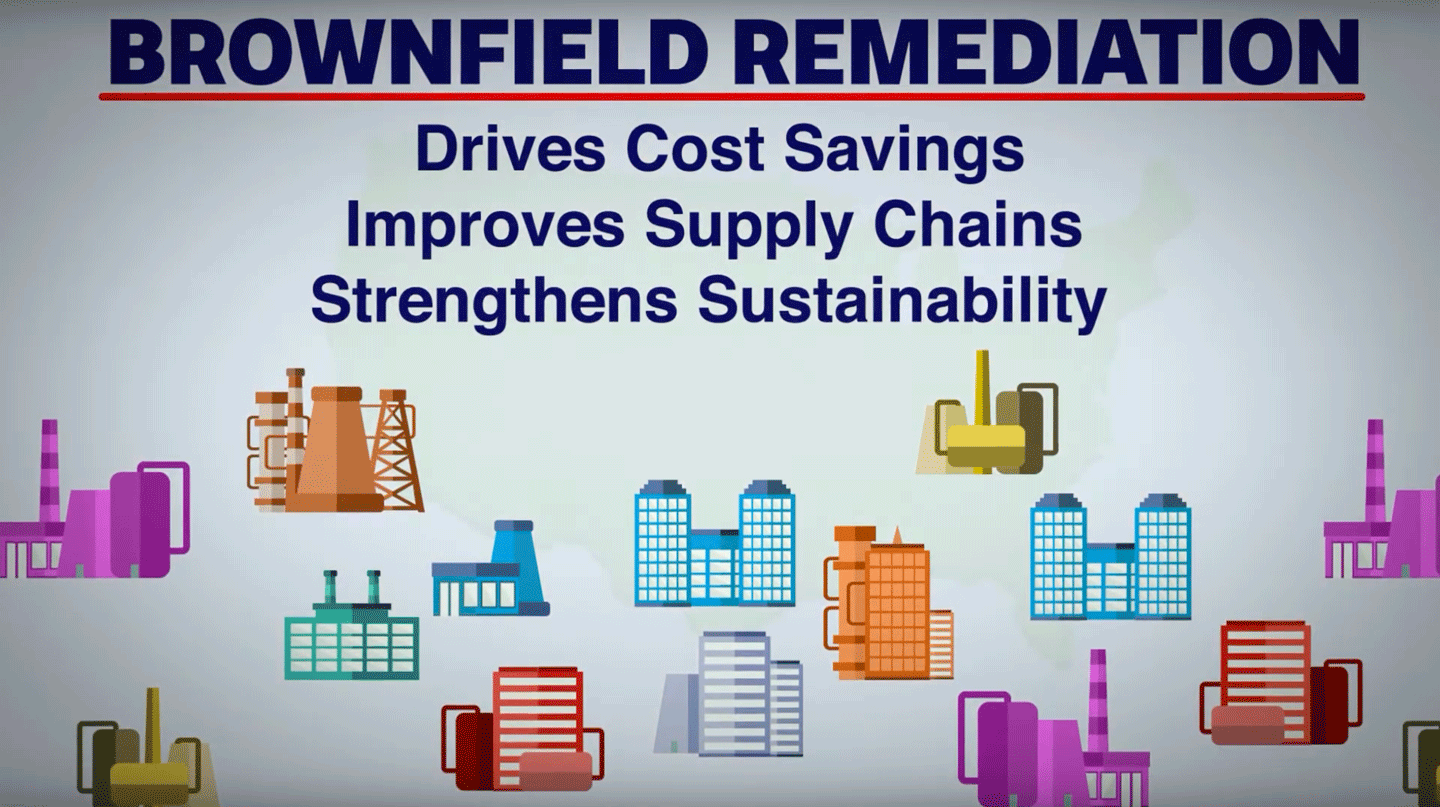Search Site
Back to Menu

Brownfield Redevelopment
Executive Summary
Brownfield redevelopments are a hot commodity in the industrial real estate space, with developers, investors and users increasingly recognizing the potential of brownfield sites to drive real estate cost savings, improve supply chain efficiencies and strengthen corporate commitments to environmental sustainability.
This paper discusses the underlying trends spurring increased investments in brownfield remediation and redevelopment projects, and the many benefits these properties hold for industrial real estate developers, investors and users.
What’s Driving Increased Investments in Brownfield Remediation and Redevelopment?
Brownfield remediation and redevelopment takes previously unusable, contaminated, polluted or hazardous property and transitions it into safe, environmentally friendly developable land.
Brownfield sites allow organizations to reuse existing infrastructure rather than tearing up farmland for greenfield development, which can be complex and costly. In crowded urban areas, brownfield redevelopment is often the only option as greenfield opportunities may not exist at all.
Large industrial organizations are turning to brownfield remediation and redevelopment programs for five important reasons:
- Lower Industrial Property Acquisition and Development Costs. Brownfield properties can often be acquired inexpensively because fewer buyers are willing to take on the challenge of remediation. As an added bonus, these projects enable companies to qualify for government incentives, tax breaks and grants, which further reduce acquisition costs. Additionally, return on investment (ROI) is enhanced because these projects significantly increase property values once cleanup is complete.
- Supply Chain Efficiencies and Transportation Savings. Brownfield sites are frequently close to urban cores and existing transportation hubs.1 Proximity to these hubs, including rail and highway infrastructure, streamlines logistics and dramatically lowers transportation costs.
- Improved Remediation and Redevelopment Capabilities in the Market. Brownfield remediation and redevelopment has come a long way in the past two decades. Experienced brownfield redevelopers like CenterPoint have streamlined their processes and created remediation frameworks that mitigate liability and economic risks, making brownfield redevelopment only marginally more complex than greenfield development.
- Contribution to USGBC LEED Certification. By locating an industrial real estate development project on a site, part or all of which is documented as contaminated, or on a site defined as brownfield by a local, state, or federal government agency, projects can earn points to achieve various levels of LEED certification. This prestigious designation demonstrates a strong commitment to sound environmental practices and is appreciated by shareholders, employees, customers and other key stakeholders.
- Positive Publicity and Advancement of Corporate Sustainability Goals. Brownfield projects create new jobs and bolster community infrastructure—a win-win for businesses, investors and the community. The company responsible for remediation gets credit not only for improving the environment, but also for fostering the economic growth of the surrounding community.
Common Brownfield Remediation and Redevelopment Challenges
There are three major challenges industrial real estate buyers and tenants face when finding and investing in a brownfield site: site selection, associated costs, and the transition to an environmentally friendly property.
- Site selection is complicated in today’s competitive economic environment. In some cases, brownfield opportunities are well known and highly sought after. In other cases, they are difficult to locate. In both instances, smart site selection requires partnering with an experienced brownfield redeveloper who knows the market and can provide accurate estimates of likely acquisition costs, remediation costs and potential government subsidies.
- Brownfield developments not only take longer to execute than greenfield properties, but also accrue much more in associated project expenses. EPA Assessment services alone cost $100,000 on average, in addition to the cost of environmental remediation, testing, and legal fees.2 Post-development, brownfield tenants may face increased labor costs as they retrain staff in new facilities or become subject to higher wage regulations in their new municipalities. At the same time, this reinvestment in staff training, education and reimbursement creates an opportunity for better workforce productivity down the line.
- Transitioning to a new property can be complex for large-scale industrial real estate buyers and tenants. The threat of production or supply chain disruptions associated with moving locations is a material risk for any company that relocates to a new industrial property. There is also a heightened risk for redeveloped brownfield property relocations due to timeline uncertainties associated with contaminant remediation. By working with experienced brownfield redevelopment experts, companies can ease the transition and reap the many business and economic benefits of these sites.
Key Considerations When Engaging Brownfield Redevelopment Partners
When evaluating partners for brownfield remediation and redevelopment, consider these important factors:
- Reputation for brownfield redevelopment. Many industrial real estate developers and contractors have “greenwashed” themselves, making overstated claims regarding their experience with brownfield redevelopment projects. Ask for a list of brownfield projects completed and drill down on the details to understand your prospective partner’s role in each project.
- Relationships with the multiple parties involved in brownfield redevelopment projects. Pursuing brownfield redevelopment requires far more than a tenant and a developer. Given the complex, sensitive nature of the land, one redevelopment initiative requires the input and approval of state and local government agencies, community groups, insurers, commercial lenders and, at times, even attorneys and environmental consultants. A partner with proven brownfield experience should have a history of successfully managing these multi-faceted relationships at each stage of the redevelopment process.
- Familiarity with federal and state regulations and remediation programs. Experienced brownfield redevelopers can help you meet federal and state regulations and reduce energy consumption and waste output, especially in build-to-suit spaces. Many states have a byzantine set of rules and regulations that govern standards on such obscure details as roof insulation thickness. A partner who knows these rules can help you not only avoid penalties or fees, but also tap into various programs that subsidize remediation projects.
CenterPoint Properties: The Market Leader in Brownfield Remediation and Redevelopment
When faced with economic, relocation and pre-existing lease challenges that affect sustainable initiatives, CenterPoint offers brokers, tenants and investors customized solutions based on unique business requirements and budget. CenterPoint views brownfield sites as unique opportunities to not only provide real estate solutions for clients, but also create new jobs, renew communities’ overarching infrastructure and, in turn, strengthen their economies.
Examples of Successful Brownfield Remediation and Redevelopment Projects
As a national leader in brownfield remediation projects, CenterPoint has worked on numerous projects that showcase the opportunity, return and benefits of revitalizing previously unusable land and repurposing it to generate economic and business growth.
- Ford Motor Company’s Manufacturing Campus Breathes New Life into 40-Year Vacant Site CenterPoint, in conjunction with the City of Chicago, developed the Ford Motor Company’s Manufacturing Campus, its first North American facility based on the “just-in-time” manufacturing model. CenterPoint’s development team worked with the City to repurpose a formal steel mill site in Southeast Chicago that sat abandoned for 40 years. The 1.6 Million square foot campus is home to an array of Ford’s top-tier suppliers, and is strategically located one-half mile away from the automaker’s Torrence Avenue Assembly Plant. By centralizing its suppliers in such close proximity to the final assembly line, Ford has been able to mitigate warehouse and distribution inefficiencies, create jobs and minimize new vehicle turnaround time from weeks to mere days.
- Intermodal Center Transforms Former Arsenal into National Logistics Hub In 2002, CenterPoint opened the CenterPoint Intermodal Center in Joliet and Elwood, Ill., a 6,500-acre project that involved the redevelopment of the former Joliet Arsenal, a U.S. superfund site. CenterPoint’s development, investment and infrastructure professionals worked alongside public agencies at virtually all levels of government, as well as private sector partners, to turn the site into a modern intermodal center and industrial business park. As part of the redevelopment process, CenterPoint orchestrated major remediation of the land’s soil and groundwater contamination, leftover after years of wartime ammunition production during the Joliet Arsenal’s existence. To date, $35 Million in grants have been secured to construct new water and sewage systems to better serve and protect park tenants and community residents. Today, CIC-Joliet/Elwood is home to the 770-acre BNSF Logistics Park-Chicago intermodal yard and 867-acre Union Pacific Joliet Intermodal Terminal, as well as national retail and logistics tenants including Walmart, Bissell and NFI.
Headquartered in Chicago, CenterPoint is a national industrial real estate firm focused on the development, acquisition and management of industrial property and transportation infrastructure. For more than two decades, CenterPoint has been a leader in brownfield remediation and redevelopment initiatives for the industrial real estate industry. We established the national model for rehabilitating blighted and underutilized industrial property into revitalized locations that comply with government regulations, reduce carbon footprints, and promote economic and business growth.
CenterPoint’s brownfield projects have earned two U.S. EPA Phoenix Awards and numerous city, state and federal accolades, including recognition from project partners and political leaders. Strategically located near ports, rail terminals and population centers, our brownfield sites help companies increase logistics efficiency and reduce drayage, energy costs, waste output and the environmental impact and cost of transportation.
Sources
Subscribe
Microsite Request
